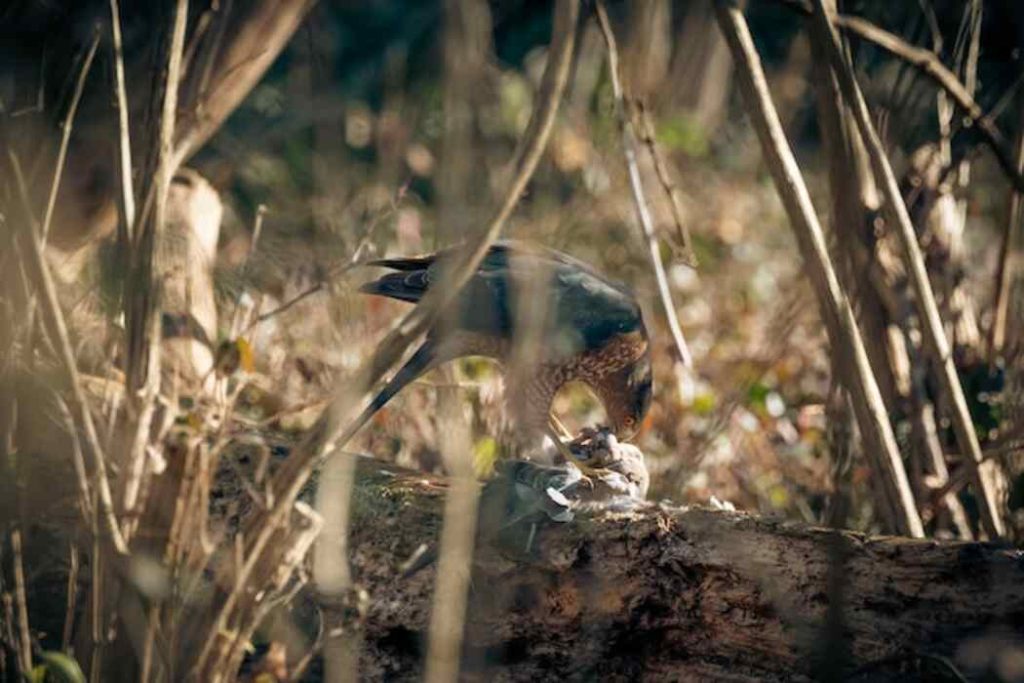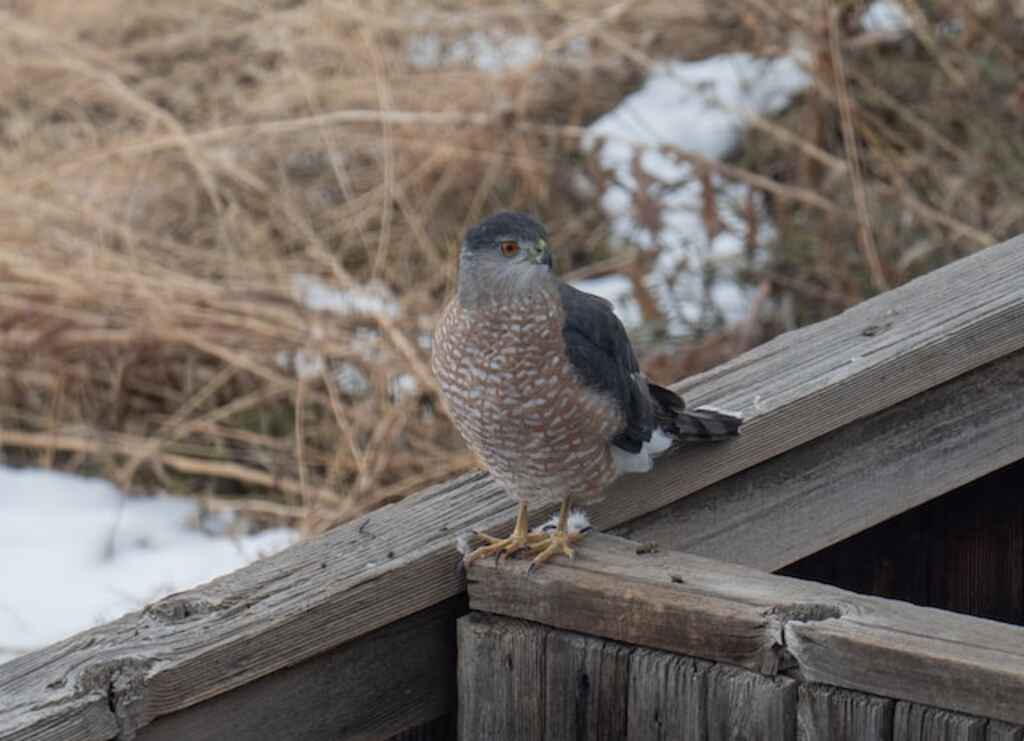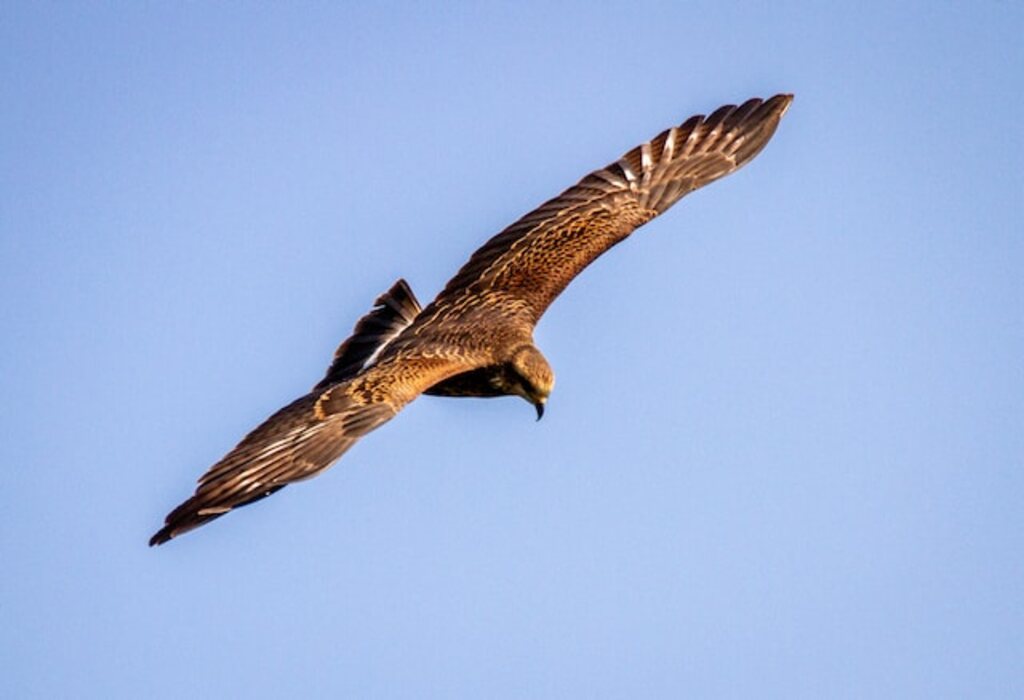Do Hawks Eat Robins? It’s a question that has plagued the minds of bird enthusiasts, worried gardeners, and even the most casual observers of nature. Well, let’s put your avian anxiety to rest: the short answer is yes.
But before you barricade your backyard with a fortress of twigs and feathers, join us on a thrilling exploration of the fascinating relationship between hawks and robins.
Prepare to be captivated by tales of aerial acrobatics, cunning strategies, and the delicate balance of the natural world.
Let’s dive into the captivating world of predator-prey dynamics, where the question isn’t just about survival, but also about the beauty and resilience of nature.
Table of Contents
- 1 Explanation of the Topic
- 2 Importance of Understanding Hawk and Robin Interactions
- 3 Overview of Hawks and Robins
- 4 Hawk Diet
- 5 Robin Diet
- 6 Hawk-Robin Interactions
- 7 Do hawks eat robins?
- 8 Conclusion
- 9 FAQs: Do Hawks Eat Robins?
- 9.1 Do hawks really eat robins?
- 9.2 Why do hawks target robins?
- 9.3 Are robins a primary food source for hawks?
- 9.4 Do hawks hunt robins in any specific season?
- 9.5 What other factors influence hawk predation on robins?
- 9.6 Do robins have any defense mechanisms against hawks?
- 9.7 Do all hawk species eat robins?
- 9.8 Are robins the only birds targeted by hawks?
- 9.9 How do hawks catch robins?
- 9.10 What is the impact of hawk predation on robin populations?
- 10 Author
Explanation of the Topic
Hawks are known for their hunting prowess, using their sharp talons and keen eyesight to catch prey from high up in the sky. They are skilled predators that can take down a variety of animals including rodents, snakes, and other birds.
Robins, on the other hand, are smaller birds known for their distinctive red breast feathers and cheerful song. They are omnivores that feed on insects, fruits, berries, and seeds.
There have been many reports of hawks attacking robins in gardens or backyards across North America.
These incidents have sparked concern among homeowners who want to protect their beloved robins from becoming prey to these powerful hunters.
But do hawks really pose a threat to robins? And if so, what factors influence hawk predation on this small bird?

Importance of Understanding Hawk and Robin Interactions
Studying the relationship between hawks and robins is not just important for bird enthusiasts; it has wider ecological implications as well.
Understanding predator-prey interactions is crucial for maintaining healthy ecosystems, as each species plays a vital role in balancing populations.
Additionally, understanding how predators like hawks target prey can help us better manage our environment by identifying areas where certain species may be at risk or where predatory pressures need to be mitigated.
It can also aid in the development of conservation strategies to protect vulnerable bird populations.
Overall, understanding the relationship between hawks and robins is essential for maintaining healthy bird communities and ensuring that these beautiful creatures continue to thrive in their natural habitat.
Overview of Hawks and Robins
Characteristics of Hawks
Hawks are birds of prey that belong to the Accipitridae family. They are known for their sharp talons, hooked beaks, and powerful wings that enable them to fly at great speeds.
There are several species of hawks found in North America, including the red-tailed hawk, Cooper’s hawk, sharp-shinned hawk and the northern goshawk.
Hawks are typically larger than other birds of prey such as falcons and eagles.
On average, they have a wingspan of 3-4 feet and weigh between 1–4 pounds. Their feathers are often brown or gray with some species having white markings on their heads or tails.
Characteristics of Robins
Robins are small to medium-sized birds that belong to the Turdidae family. They have a distinctive red-orange breast that is easy to spot from afar.
Their feathers on the back and wings tend to be gray-brown in color, while their bellies can range from white to pale yellow.
Adult robins weigh between 2–3 ounces and have a wingspan of approximately 10 inches. Males tend to be slightly larger than females, but otherwise look similar in appearance.
Habitat and Behavior of Hawks and Robins
Hawks can be found in a variety of habitats ranging from forests to grasslands, deserts, wetlands, and even urban environments.
Some species like the red-tailed hawk prefer open habitats, while others like Cooper’s hawks prefer denser forests.
Robins prefer forested areas with open spaces, such as fields or parks, where they can forage for food more easily.
They also enjoy perching on tree branches or fences where they have an unobstructed view of their surroundings.
Both hawks and robins are diurnal, which means they are active during the day and sleep at night.
Hawks tend to be solitary birds, while robins are social and can often be seen in flocks. Hawks primarily hunt from the air while robins feed on the ground, foraging for worms, insects, fruits, and seeds.
Hawks are known for being raptor predators with sharp talons and beaks that make them skilled hunters of small animals.
Their diet mainly consists of small mammals, reptiles, insects, and birds. These birds of prey play a crucial role in maintaining ecological balance by keeping populations of other animals in check.
In the nest section, we will discuss the types of prey hawks eat, their hunting techniques and the factors that influence their diet.

Hawk Diet
The type of prey hawks eat varies depending on several factors such as species, age and location. Some common types of prey include mice, voles, squirrels, rabbits and other small mammals.
Hawks also feed on reptiles like snakes and lizards, as well as insects including grasshoppers and crickets.
While most hawks feed on these animals throughout the year, some may change their diet seasonally to adapt to changing weather conditions or availability of food sources.
For example, during winter months when small mammals are scarce due to hibernation or migration patterns – some hawks may switch to feeding on birds instead.
Hawks use various hunting techniques depending on species and location.
One common technique is called “still-hunting” where they perch or hover in one spot waiting for prey to come into view before swooping down at high speed with their sharp talons extended.
Another technique is called “ambush-hunting” where they hide behind trees or bushes waiting for unsuspecting prey to come close enough before pouncing on it swiftly.
Furthermore, some hawks hunt cooperatively in a team, with other members using different tactics to distract or flush out prey from hiding spots before one member swoops in for the kill.
Several factors influence hawk diet such as availability of food sources which can be affected by seasonal changes, habitat destruction and climate change.
For example, hawks that rely on small mammals may struggle to find food in areas where urban development has reduced the availability of natural habitats.
Competition with other predators for food resources can also affect hawk diet.
For instance, if a hawk territory overlaps with that of an owl or other raptor species – they may be forced to hunt for different prey to avoid competition.
As hawks grow older, their dietary preferences may change as they become more experienced hunters and start targeting larger prey or specialize in hunting specific types of animals.
Robin Diet
Robins are small songbirds that are widespread across North America. They have a varied diet that includes insects, fruits, and seeds.
The specific types of food robins eat vary depending on the season and availability of resources.
Insects make up a significant portion of their diet during the breeding season, while fruits and berries become more important during the fall migration.
Types of food robins eat
During the breeding season, robins primarily feed on earthworms and other insects. They will also consume spiders, snails, slugs, and small crustaceans if they find them.
As summer approaches, their diet shifts to include more fruits such as cherries, blueberries, raspberries, blackberries and other soft fruits as they become available in gardens or in wooded areas near human habitation.
During winter months when insects are scarce or non-existent in colder regions where they nest in, summers will shift to berries from various trees such as hawthorns or mountain ash trees which provide them with nutrition for their energy requirements.
Feeding habits and preferences
Robins generally feed on the ground or near it due to their stout legs designed for hopping rather than walking.
They search for food by walking along the ground with a distinctive head tilt that helps them spot prey hidden among leaves and grasses.
Robins also use their sense of hearing to locate prey; they can hear worms moving underground from several feet away.
Robins prefer open habitats like gardens or lawns with scattered trees for easy predator detection while feeding.
However, during nesting in summer months, their preferences shift towards dense vegetation, providing cover as they feed on shrubs and hedges nearby.
Factors that influence robin diet
Several factors can influence what robins eat at any given time. Availability is one such important factor; a scarcity of insects may force the bird to seek out alternative food sources like fruit or even small reptiles or amphibians.
Other factors include habitat type, weather conditions and seasonal changes affecting food availability.
Robins will also show preferences for certain types of food depending on their personal dietary needs, as well as the feeding habits of other species present in the same area.
For example, when insects are scarce, robins will compete with other birds like blue jays and cardinals for available fruits and berries.
Overall, understanding what robins eat and how they obtain their food is an important aspect of studying their behavior and ecology.

Hawk-Robin Interactions
Do hawks eat robins?
Yes, hawks do eat robins. Robins are a common prey item for many hawk species due to their size and availability. Hawks are skilled hunters and have adapted to capture a variety of prey, including small birds like robins.
The predation behavior of hawks targeting robins is influenced by factors such as habitat, behavior, and seasonal variations.
Understanding these interactions helps shed light on the dynamics of avian ecosystems and the role of hawks as predators.
Predation behavior between hawks and robins
Hawks are opportunistic hunters, and they will prey on any available bird species, including the robin. When hunting robins, hawks usually attack them from above while they are on the ground searching for food or building their nests.
Hawks have sharp talons that can easily grasp birds of similar size or smaller like robins.
They use their beaks to quickly kill their prey by biting through the neck or head. Robins are aware of the danger posed by hawks and have developed strategies to avoid being caught.
When a hawk is near, robins will fly to cover in bushes or trees to hide themselves from predators. Robins also form large groups which make it harder for hawks to target an individual bird.
Reasons why hawks may target robins as prey
Hawks typically prey on smaller birds because they are easier targets than larger birds.
Robins are a common food source for hawks because they tend to feed close to the ground and in open areas where they can easily be seen by predators like hawks.
Additionally, robins have a high population density in many areas, making them an abundant source of food for hungry hawks.
Another reason why hawks may target robins is that they provide a good source of nutrition.
Robins are rich in protein and contain essential nutrients such as iron and B vitamins that help maintain healthy feather growth.
Impact on robin populations
The predation of robins by hawks can impact their populations significantly, especially during nesting season, when parents search for food more frequently than usual.
If too many robins fall prey to hawk attacks, it could lead to a decline in robin populations over time.
However, some studies suggest that predation can play an important role in regulating bird populations.
Hawks help to control the population of smaller birds like robins by removing the weak and sickly individuals from the population. This can result in a stronger, healthier bird population overall.

Conclusion
The relationship between hawks and robins is complex and dynamic. While hawks view robins as a potential food source, robins have developed strategies to avoid predation by hawks to protect their populations.
Understanding this relationship is essential for conservation efforts aimed at protecting bird populations from predator attacks.
It’s important to remember that predation plays a vital role in regulating animal populations and maintaining ecosystem balance.
While it may be difficult to watch one species attack another, it’s crucial not to intervene too much in natural ecosystems, as doing so can cause unforeseen consequences down the line.

FAQs: Do Hawks Eat Robins?
Do hawks really eat robins?
Yes, hawks do eat robins. Robins are a common prey item for many hawk species due to their size and availability.
Why do hawks target robins?
Hawks target robins as prey due to their size, behavior, and habitat preferences. Robins are often found in open areas, making them more visible to hunting hawks.
Are robins a primary food source for hawks?
While robins are not a primary food source for hawks, they are frequently consumed when available. Hawks have a diverse diet, including various bird species.
Do hawks hunt robins in any specific season?
Hawk predation on robins can occur throughout the year, but nesting season and summer months may witness increased hawk targeting of robins due to their presence in dense vegetation.
What other factors influence hawk predation on robins?
Factors such as habitat, prey availability, hunting techniques, and regional hawk species distribution can influence the frequency of hawk predation on robins.
Do robins have any defense mechanisms against hawks?
Robins rely on their ability to detect predators and seek cover in dense vegetation when threatened. Their alert behavior and use of natural cover can provide some defense against hawks.
Do all hawk species eat robins?
Not all hawk species eat robins, as their diet varies depending on their size, hunting techniques, and habitat preferences. However, robins are commonly targeted by various hawk species.
Are robins the only birds targeted by hawks?
No, hawks target a wide range of bird species depending on their size and availability. Other small to medium-sized birds may also be on the hawk’s menu.
How do hawks catch robins?
Hawks are skilled hunters that catch robins by swooping down from perches or soaring in the air. They use their sharp talons to seize the prey and carry it away.
What is the impact of hawk predation on robin populations?
Hawk predation can have an impact on robin populations, especially in areas with high hawk densities. However, the overall effect depends on various factors, including the availability of alternative food sources and habitat conditions.


